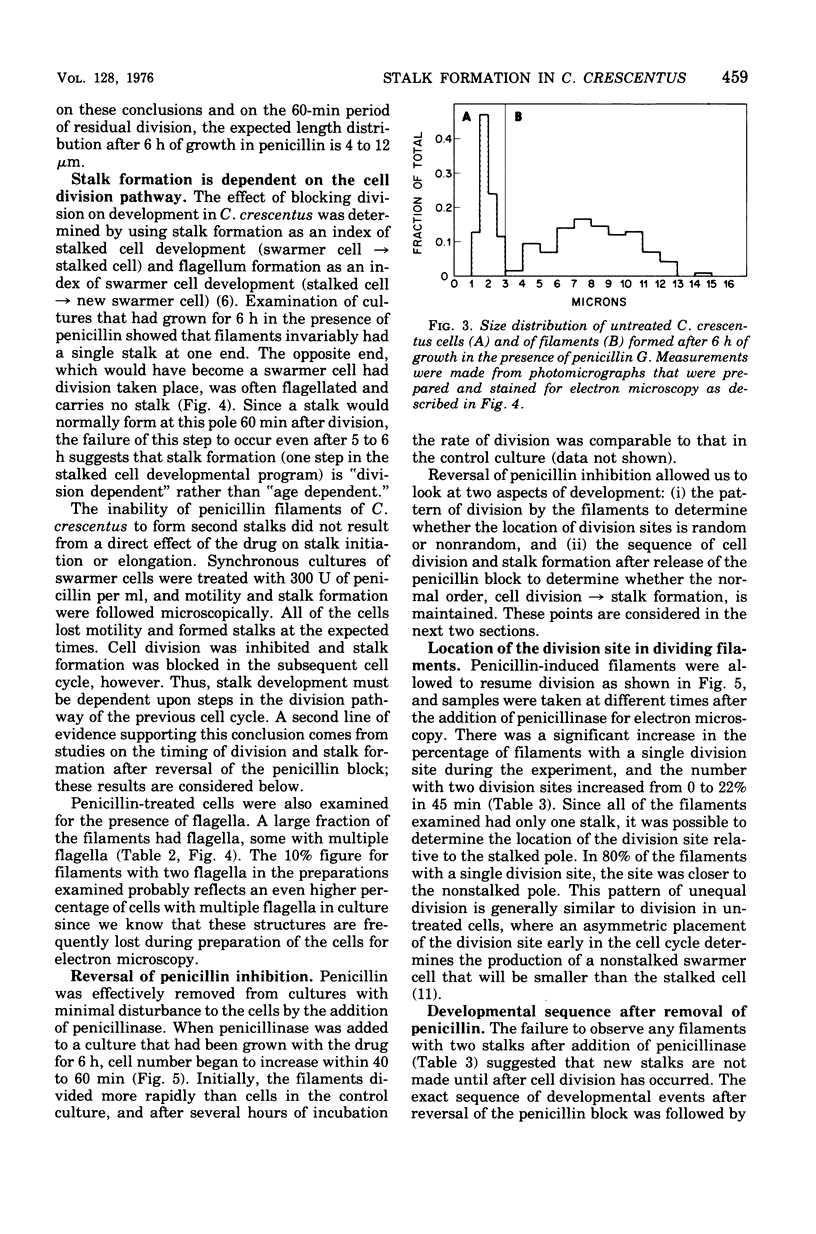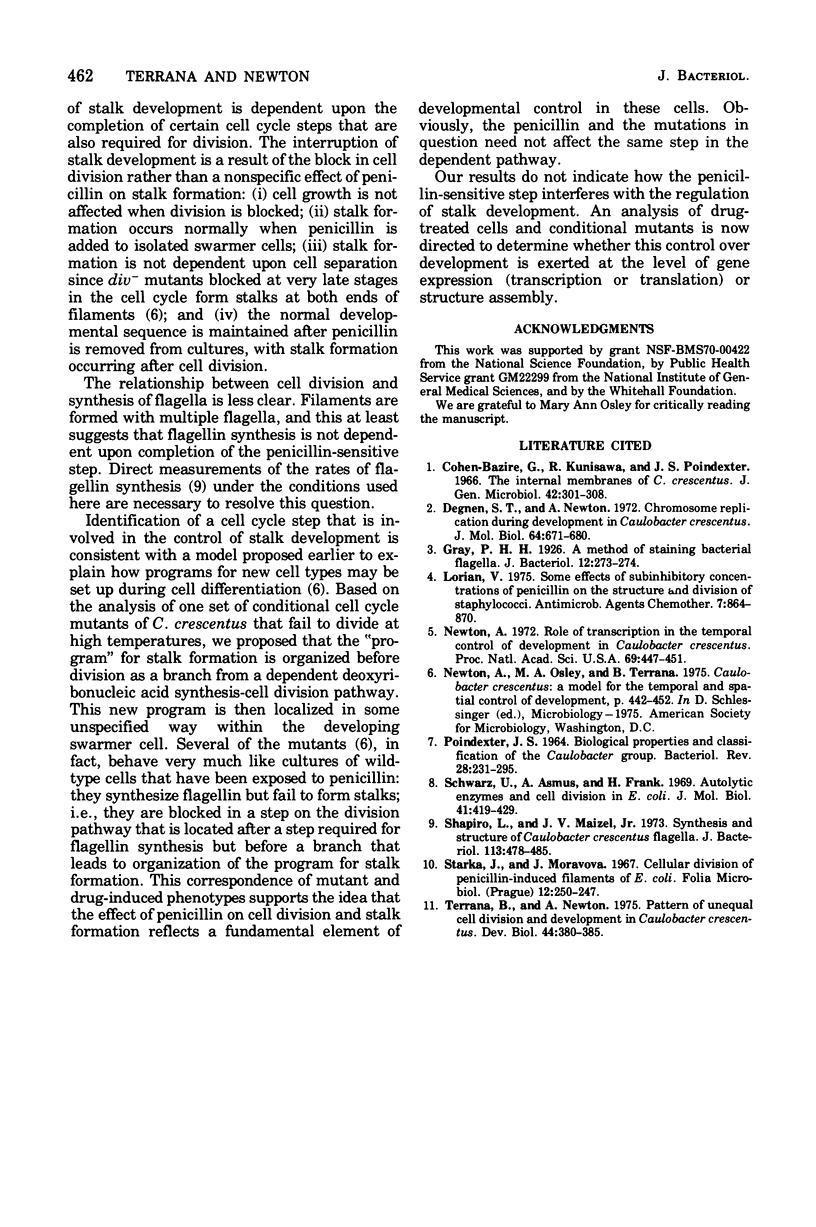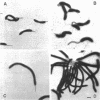Abstract
Penicillin G at low concentrations blocked cell division in Caulobacter crescentus without inhibiting cell growth. The long filamentous cells formed after two to three generations under these conditions had a stalk at one pole and usually one or more flagella at the opposite pole. The failure of the filaments to form a second stalk at the flagellated pole indicates that stalk formation was dependent upon completion of a step that was also required for cell division. Two observations support this conclusion. (i) Penicillin did not stop the normal development of synchronous swarmer cells into stalked initiation and stalk elongation. (ii) When the action of penicillin was reversed by the addition of penicillinase to cultures of filaments, stalks were not formed at the nonstalked pole until after cell division had occurred; thus the normal order of development events was maintained: cell division leads to stalk formation. These results are consistent with a model in which the organization of the developmental program for stalk formation occurs before cell division as a consequence of steps that branch from the cell division pathway.
Full text
PDF






Images in this article
Selected References
These references are in PubMed. This may not be the complete list of references from this article.
- Cohen-Bazire G., Kunisawa R., Poindexter J. S. The internal membranes of Caulobacter crescentus. J Gen Microbiol. 1966 Feb;42(2):301–308. doi: 10.1099/00221287-42-2-301. [DOI] [PubMed] [Google Scholar]
- Degnen S. T., Newton A. Chromosome replication during development in Caulobacter crescentus. J Mol Biol. 1972 Mar 14;64(3):671–680. doi: 10.1016/0022-2836(72)90090-3. [DOI] [PubMed] [Google Scholar]
- Gray P. H. A METHOD OF STAINING BACTERIAL FLAGELLA. J Bacteriol. 1926 Oct;12(4):273–274. doi: 10.1128/jb.12.4.273-274.1926. [DOI] [PMC free article] [PubMed] [Google Scholar]
- Lorian V. Some effect of subinbilitory concentrations of penicillin on the structure and division of staphylococci. Antimicrob Agents Chemother. 1975 Jun;7(6):864–867. doi: 10.1128/aac.7.6.864. [DOI] [PMC free article] [PubMed] [Google Scholar]
- Newton A. Role of transcription in the temporal control of development in Caulobacter crescentus (stalk-rifampin-RNA synthesis-DNA synthesis-motility). Proc Natl Acad Sci U S A. 1972 Feb;69(2):447–451. doi: 10.1073/pnas.69.2.447. [DOI] [PMC free article] [PubMed] [Google Scholar]
- POINDEXTER J. S. BIOLOGICAL PROPERTIES AND CLASSIFICATION OF THE CAULOBACTER GROUP. Bacteriol Rev. 1964 Sep;28:231–295. doi: 10.1128/br.28.3.231-295.1964. [DOI] [PMC free article] [PubMed] [Google Scholar]
- Schwarz U., Asmus A., Frank H. Autolytic enzymes and cell division of Escherichia coli. J Mol Biol. 1969 May 14;41(3):419–429. doi: 10.1016/0022-2836(69)90285-x. [DOI] [PubMed] [Google Scholar]
- Shapiro L., Maizel J. V., Jr Synthesis and structure of Caulobacter crescentus flagella. J Bacteriol. 1973 Jan;113(1):478–485. doi: 10.1128/jb.113.1.478-485.1973. [DOI] [PMC free article] [PubMed] [Google Scholar]
- Stárka J., Moravová J. Cellular division of penicillin-induced filaments of Escherichia coli. Folia Microbiol (Praha) 1967;12(3):240–247. doi: 10.1007/BF02868738. [DOI] [PubMed] [Google Scholar]
- Terrana B., Newton A. Pattern of unequal cell division and development in Caulobacter crescentus. Dev Biol. 1975 Jun;44(2):380–385. doi: 10.1016/0012-1606(75)90409-1. [DOI] [PubMed] [Google Scholar]



